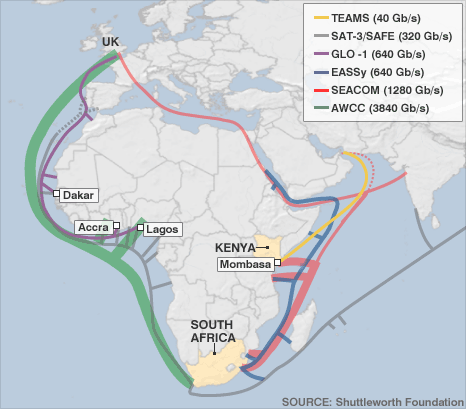CottonEyeJoe
JF-Expert Member
- Jan 8, 2008
- 331
- 72
I think that pricing is incorrect, I believe the wholesale price is more like $40 per 1MB
SEACOM, set to be operational by 17 June 2009, has released an aggressive pricing structure on international bandwidth.
SEACOM and Tyco Telecommunications began construction of the 13 700 km South and East Africa submarine cable systems towards the end of last year.
The SEACOM project is already fully funded with African investors Industrial Promotion Services, Venfin, Convergence Partners and Shanduka Group owning 76.25% of the project.
Pricing
Brian Herlihy, SEACOM president, said that the idea behind the cable is to offer international bandwidth at a lower price but to increase usage to ensure profits.
In a move seldom experienced in the local telecoms arena, SEACOM revealed their wholesale pricing structure and strategy to the media.
The company will have a four tiered bandwidth pricing approach where bandwidth prices for larger products, in this case STM-64, STM-16 and STM-4 connections, are sold at reduced rates to the standard STM-1 connection.
Their price for an STM-1 connection however sets a roof for the resale of bandwidth by larger bulk-bandwidth buyers thereby ensuring that smaller players receive a competitive rate.
The price for an
STM-64 connection, supplying 9.6 Gbps of bandwidth, is $ 1 663 875 or R 267-00 ( $33) per Mbps per month.
The price per Mbps per month for a STM-1 (155 Mbps) service is R 673-00($83)
while a STM-4 (600 Mbps) connection costs R 575-00 ($71) and a
STM-16 (2.5 Gbps) service will cost R 435-00 ($54).
It should be noted that this is a full bandwidth solution from a local point of presence, typically Johannesburg, to an international destination like London. There is hence no additional local bandwidth cost over and above the international rates. Onward bandwidth arrangements have also been finalized Herlihy said.
This tariff compares vary favorably against the other options in the market. According to SEACOM the R 267-00 per Mbps per month is multiple times lower that of Satellite at R 231 000, Telkoms SAT3 (JHB/CPT to beach) ranging between R 3 500-00 and R 11 000-00 and EASSy promising rates of R 1 400-00 from the beach to Sudan (local and onward bandwidth charges are likely to increase this price significantly).
The new cable system further committed to reducing the cost of international bandwidth to Universities and Research Institutions in South Africa by 5 000%.
SEACOM and TENET plan to provide these institutions with 50 times more bandwidth than what they currently have.
Kitu unachosahau ni kwamba ISP zanatumia methods tofauti kabisa kuuza bandwidth zao. Bandwidth 1Mb inaweza uzwa kwa watu hata 100 kwa bei ya chini kabisa. wenyewe wananunua Mbs Kibao halafu wanaziweka kwenye pool na hiyo pool inakuwa over-subcribed. Lakini wanajua kwa hakika kwamba haitawezekana watu wote waliopo kwenye Pool "A" waka-access / download kwa muda mmoja."The price per Mbps per month for a STM-1 (155 Mbps) service is R 673-00($83)"
Mkuu; ukishangaa ya Mussa utaona ya Firauni, hizo ndo siasa za biashara . . .
Actuals: Kwa waliosaini MoU ya STM-1 Tayari, purchase price ni $ 700 kwa 1 Mbps (Full Duplex).
You cant sell on loss + Investment. So, the best price to expect is not less than $ 1000 PM.
Some companies ISP has already given prices 1 Mbps between $ 1500 - 1800 Per Mbps.
Kitu unachosahau ni kwamba ISP zanatumia methods tofauti kabisa kuuza bandwidth zao. Bandwidth 1Mb inaweza uzwa kwa watu hata 100 kwa bei ya chini kabisa. wenyewe wananunua Mbs Kibao halafu wanaziweka kwenye pool na hiyo pool inakuwa over-subcribed. Lakini wanajua kwa hakika kwamba haitawezekana watu wote waliopo kwenye Pool "A" waka-access / download kwa muda mmoja.
ISP inanunua dedicated line zenye uwezo tofauti.
Endi User(home) ananunua Shared (pool) lines.
However, analysts are sounding the alarm that the country may wind up with too much broadband connectivity as players in the industry have bought more capacity than they are willing to handle
Suala la ei litachukua muda kidogo......fiber to home project pia itachukua muda mrefu zaidi......ingawa ttcl wana haki zote kusambaza fiber to home.....je itawalipa??hao ttcl??

